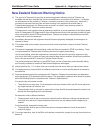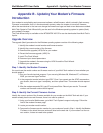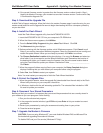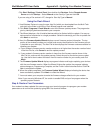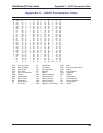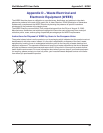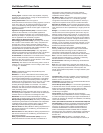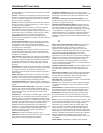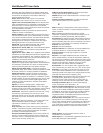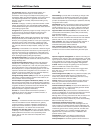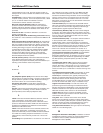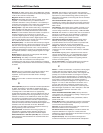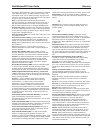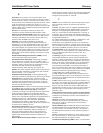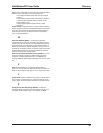
Glossary
38
MultiModemZPX User Guide
Serial Bus. The Device Address is the Default Address when
the Universal Serial Bus device is first powered or reset. Hubs
and functions are assigned a unique Device Address by
Universal Serial Bus software.
Device driver: Software that controls how a computer
communicates with a device, such as a printer or mouse.
Digital Cross-connect System (DCS): The CO device which
splits and redistributes the T1 bandwidth. the DCS takes time
slots from various T1 lines and alters them to provide the
needed connectivity. DCS connections are made with software
at an administrator’s workstation.
Digital Data: Information represented by discrete values or
conditions (contrast “Analog Data”).
Digital Loopback: A technique used for testing the circuitry of
a communications device. Can be initiated locally, or remotely
(via a telecommunications device). The tested device decodes
and encodes a received test message, then echoes the
message back. The results are compared with the original
message to determine if corruption occurred en route.
Digital PBX: A Private Branch Exchange that operates
internally on digital signals. See also “Exchange”.
Digital Service, level 0 (DS0): The world-wide standard speed
(64 Kbps) for digital voice conversation using PCM (pulse
coded modulation).
Digital Service, level 1 (DS1): The 1.544M bps voice standard
(derived from an older Bell System standard) for digitized voice
transmission in North America. The 1.544M bps consists of 24
digitally-encoded 64 Kbps voice channels (north America) and
2.048M bps (30 channels) elsewhere.
Digital Signal: A discrete or discontinuous signal (e.g., a
sequence of voltage pulses). Digital devices, such as terminals
and computers, transmit data as a series of electrical pulses
which have discrete jumps rather than gradual changes.
Digital Signaling Rates (DSn): A hierarchical system for
transmission rates, where “DS0” is 64 Kbps (equivalent to ISDN
B channel), and DS1 is 1.5 Mbps (equivalent to ISDN PRI).
Digital Transmission: A method of electronic information
transmission common between computers and other digital
devices. Analog signals are waveforms: a combination of many
possible voltages. A computer’s digital signal may be only “high”
or “low” at any given time. Therefore, digital signals may be
“cleaned up” (noise and distortion removed) and amplified
during transmission.
Digitize: To convert an analog signal to a digital signal.
DIP switch (pronounced “dip switch”): A set of tiny toggle
switches, built into a DIP (dual in-line package), used for setting
configurable parameters on a PCB (printed circuit board).
Downstream: The direction of data flow from the host or away
from the host. A downstream port is the port on a hub
electrically farthest from the host that generates downstream
data traffic from the hub. Downstream ports receive upstream
data traffic.
Driver: When referring to hardware, an I/O pad that drives an
external load. When referring to software, a program
responsible for interfacing to a hardware device; that is, a
device driver.
Drop and Insert: The process where a portion of information
carried in a transmission system is demodulated (“Dropped”) at
an intermediate point and different information is included
(“Inserted”) for subsequent transmission.
DTE (Data Terminal Equipment): A term used to include any
device in a network which generates, stores or displays user
information. DTE is a telecommunications term which usually
refers to PCs, terminals, printers, etc.
DTMF (Dual-Tone MultiFrequency): A generic push-button
concept made popular by AT&T TouchTone.
DWORD: Double word. A data element that is 2 words, 4 bytes,
or 32 bits in size.
Dynamic Insertion and Removal: the ability to attach and
remove devices while the host is in operation.
E
E&M: A telephony trunking system used for either switch-to-
switch, or switch-to-network, or computer/telephone system-to-
switch connection.
EIA: The Electronics Industries Association is a trade
organization in Washington, DC that sets standards for use of
its member companies. (See RS-232, RS-422, RS530.)
Encapsulation: A technique used by network-layer protocols in
which a layer adds header information to the protocol data unit
from the preceding layer. Also used in “enveloping” one protocol
inside another for transmission. For example, IP inside IPX.
End User: The user of a host.
Endpoint: See Device Endpoint.
Endpoint Address: The combination of a Device Address and
an Endpoint Number on a Universal Serial Bus device.
Endpoint Number: A unique pipe endpoint on a Universal
Serial Bus device.
Ethernet: A 10-megabit baseband local area network that
allows multiple stations to access the transmission medium at
will without prior coordination, avoids contention by using carrier
sense and deference, and resolves contention by using collision
detection and transmission. Ethernet uses carrier sense
multiple access with collision detection (CSMA/CD).
Excess Zeros: A T1 error condition that is logged when more
than 15 consecutive 0s or fewer than one 1 bit in 16 bits occurs.
Exchange: A unit (public or private) that can consist of one or
more central offices established to serve a specified area. An
exchange typically has a single rate of charges (tariffs) that has
previously been approved by a regulatory group.
Exchange Area: A geographical area with a single uniform set
of charges (tariffs), approved by a regulatory group, for
telephone services. Calls between any two points within an
exchange area are local calls. See also “Digital PBX”, “PBX”.
Exchange Termination (ET): The carrier’s local exchange
switch. Contrast with “Loop Termination - LT”.
Explicit Congestion Management: The method used in frame
relay to notify the terminal equipment that the network is overly
busy. The use of FECN and BECN is called explicit congestion
management. Some end-to-end protocols use FECN or BECN,
but usually not both options together. With this method, a
congestion condition is identified and fixed before it becomes
critical. Contrast with “implicit congesion”.
Extended Super Frame (ESF): One of two popular formats for
framing bits on a T1 line. ESF framing has a 24-frame super-
frame, where robbed bit signaling is inserted in the LSB (bit 8 of
the DS-0 byte) of frames 6, 12, 18 and 24. ESF has more T1
error measurement capabilities than D4 framing. Both ESF and
B8ZS are typically offered to provide clear channel service.
F
Failed Seconds: A test parameter where the circuit is
unavailable for one full second.
Failed Signal: A T1 test parameter logged when there are more
than 9 SES (Severely Errored Seconds).



